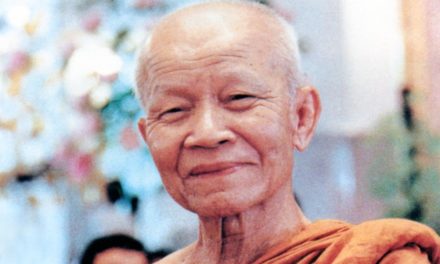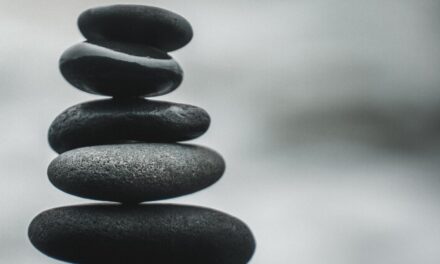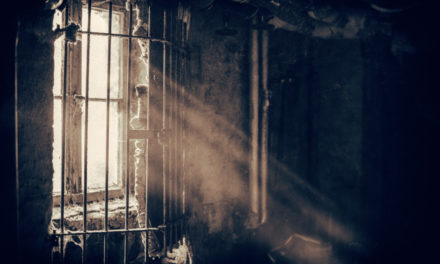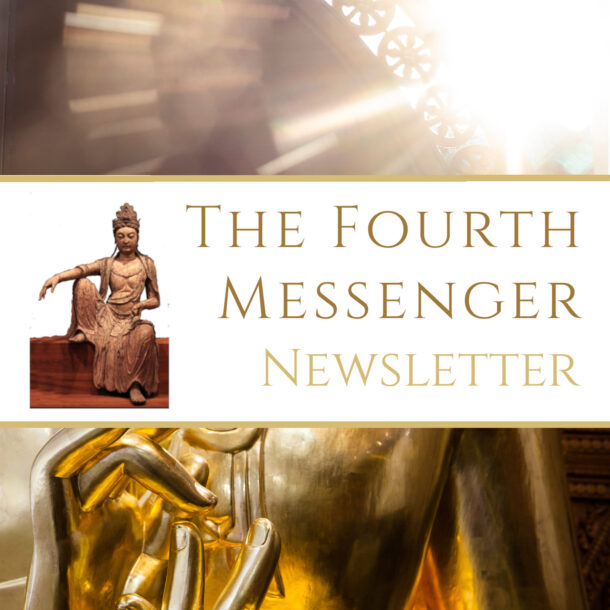Lotuses under Eucalyptus: Faith, Giving, & the Founding of Dhammagiri in Australia
by Tan Nisabho | Jan. 25, 2022
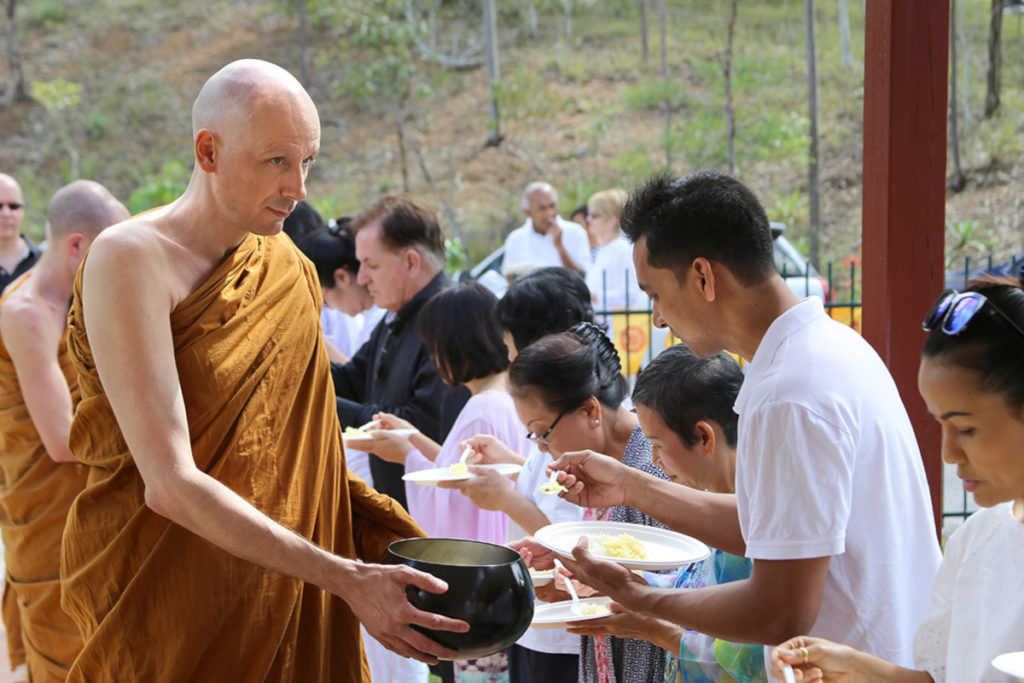
Ajahn Dhammasiha, abbot of Dhammagiri Forest Hermitage in Brisbane, Australia, accepts alms from one of the many faithful who have gathered together to support the often challenging and sometimes miraculous project.
To learn more about Dhammagiri, visit https://www.dhammagiri.net/
The Beginning
In April of 2007, during the worst drought in Brisbane’s history, a battered white Mercedes struggled up the lightly-forested hill that was to be the site of the new Dhammagiri Forest Hermitage. While blessed with a view of the D’Aguilar National Park and located only a forty-five minute commute from the city, the eighty-five acres nonetheless might have evoked worry in the tall monk sitting in the passenger seat. To drive up, let alone build on, the intimidatingly-steep hill that dominated most of the land would require the same persistence shown by the heat-gnarled ironbark clinging to its slopes.
Ajahn Dhammasiha had only recently grown familiar with the Gray Gum and twisted Eucalyptus that covered the hills of Australia. Born in Germany, a spiritual hunger drove him from his just-commenced PhD studies near home to a hotel room in Allahabad, India, where he struggled to figure out how to give himself to the spiritual path while still protecting the life he’d worked so hard to create.
“In the end, I decided it’s just not possible to work this out beforehand,” he remembers, “and I dropped it all, deciding to stay in India for two years until my visa and money ran out. The decision was sealed by a bath in the Ganges at the festival of Ardh Mela, when hundreds of thousands of devotees bathe together. After that act of letting go of the PhD and the recently approved scholorship, everything fell into place easily. I stumbled across the Dhammapada in one of the few bookstores in Allahabad that carried English books. Reading that, I thought, ‘I’m a Buddhist!'”
Ajahn Dhammasiha travelled to Sri Lanka to ordain, studying suttas and practicing meditation for three years before deciding, in 1998, to leave for an Australian monastery in the tradition of Ajahn Chah. His towering figure belies a soft tone sweetened with round German vowels, and the fluent Pali references peppering his teachings indicate his Sri Lankan training. One such talk given the previous year at a Brisbane temple had inspired an invitation to start a forest hermitage nearby.
While the prospect of founding a monastery in a country unfamiliar with Buddhist monasticism was intimidating, Ajahn Dhammasiha agreed to move to a newly-purchased piece of land on the city’s outskirts and see how far his and the laity’s faith could would take things.
Stepping out of the Mercedes onto the drought-withered hill, he hoped it had been the right decision.
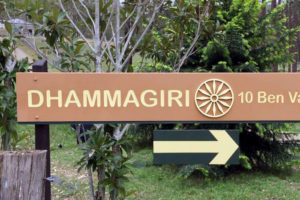

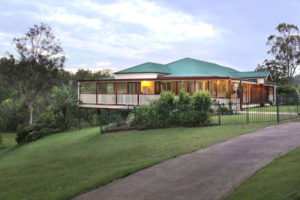
The Doctor
Switching off the engine, an elderly Sri Lankan man with a cropped silver beard clambered out of the driver’s seat and checked to make sure the thousand liter water tank was still hitched to the truck. A senior neurologist in his mid-seventies, Dr. Gamini didn’t do such work often, but the determined look on his face bespoke a faith that had already made him give far more. He pulled behind him not just the new monastery’s water supply, but also the fledgling support of the Buddhist nonprofit he led. The organization, Brisbane Vihara Inc. had looked after a small Sri Lankan center in the city for nearly thirty years, and many in it balked when their president, inspired by Ajahn Dhammasiha’s teaching, suggested they sell the old property to start a forest monastery in an unfamiliar tradition. Dr. Gamini responded to the group’s hesitation by guaranteeing the new monastery’s mortgage from his personal account.
“There was considerable opposition,” Dr. Gamini smiled later, “But we wanted to support monks who practice the Dhamma seriously and will then be able teach us. I think people are very lost. They are driven by self-oriented motives. The Dhamma brings them back. To go every Sunday and listen to a sermon or talk with the monks brings us back to ourselves and we realize that those things are empty, and we therefore modify our lives accordingly.”
Ajahn Dhammasiha remembers the doctor’s support as one of the key factors allowing him to come: “It was incredibly courageous of Dr. Gamini to invite me. I was only eleven Rains and had been at an obscure hermitage, but he moved the whole community to establish a forest monastery. Most people simply respected him so much that they didn’t want to vote against his suggestion, but it didn’t necessarily mean that they were all wholeheartedly supporting it.“
One could understand their hesitation. Apart from a steep access road and out-of-use water tank, the property had no facilities. The tent erected as a temporary shelter was neither insulated against the coming winter or, as they would find out within the first few days, rainproof. To build anything new would require creating a level space on land so steep that Dr. Gamini at one point had to personally prove to a host of skeptical Sri Lankan grandmothers that it was accessible by driving his old Mercedes up the thirty-degree gradient. Just to run a power line up the hill was estimated at a quarter-million dollars.
The Sangha’s sincerity, however, inspired the lay community to work around even such obstacles. Ajantha, one of the Sri Lankan supporters living in the Western suburbs, found the property, negotiated the purchase, and handled all contractors for the numerous works required to build on the rugged terrain. He even negotiated the price of the power, water, and phone lines down from their original price to under one-hundred thousand.
“People had suggested that I could stay in one of the other temples while we developed the monastery,” Ajahn Dhammasiha remembers, “but I just made the resolution that I would actually stay from day one, never mind what kind of facilities we had, and so everyone knew it was really happening here, and people appreciated that.”
Apart from depending on a core of faithful to organize the construction of a small demountable study and kitchen, the Sangha’s prohibition against handling money or storing food made them reliant on the daily generosity of the lay community for life’s most basic needs.
“Dr. Gamini’s wife was organizing the dāna roster and convincing people so that every day a person would come out,” Ajahn Dhammasiha remembers, “She and her family would often fill in if they couldn’t find anyone else.”
Over time, people became more involved. Leigh, a local crane operator first dragged to Dhammagiri by his wife, felt so touched by the generosity at the monastery that he began to devote most of his time to helping with its construction and landscaping. For months on end he worked pouring cement, installing new water tanks, laying an irrigation system, and even refurbishing a decaying Buddha image. Before, he’d known nothing about Buddhism, but now found himself working, sometimes from early in the morning until late at night, and asking for nothing in return.
Leigh reflected on what inspired him: “Outside everyone was always just like, ‘take, take, take’. It was all, ‘Put in twelve to fourteen hours and make as much money as you can’ — and that’s all you had. That’s all you did. At the monastery, it’s just not like that. There’s still people in the world that care and want to make a difference. The first time I was there, we were new people, we didn’t know anyone, and they invited us to the meal right away. They didn’t have to invite us but they did.”
An office and restrooms constructed in demountable shipping containers joined the kitchen as the number of supporters grew. After several years, up to one-hundred visitors would drive out on important days to sit meditation and hear teachings. Yet even with the monastery’s growing success, Ajahn Dhammasiha continued to rely on Dr. Gamini when anything urgent arose.
“If I needed silicon to seal a leak in the meeting tent,” Ajahn Dhammasiha reflects, “I could call him and he’d buy it in the evening after finishing work. He’s still working in his eighties to earn a little money to support the monastery, and so he would drive the hundred kilometers back from his surgery to his home and on the way would buy whatever I needed. To get to the monastery is one hour’s drive, so the next morning he would leave his home at 4:30 a.m., drive out here, give whatever was required, drive back home, drive the hundred kilometers back to his surgery, and then do his work as a neurologist.”
Yet even though Dr. Gamini continued to personally guarantee Dhammagiri’s new purchases and negotiate the nonprofit’s administrative politics and procedures, Ajahn Dhammasiha remembers him most for his simple kindnesses: “Once, when I’d just come back from visiting my parents in Germany, he picked me up from the airport in the middle of the night and asked me, ‘Is there anything you need?’. I mentioned that I would require a new battery for my watch, and without saying anything, he took his own watch off his wrist and gave it to me. I refused, but it shows his character. He would give you the watch off his own wrist.”
The Tripitika Chanter
After a year of building, months of landscaping, and countless acts of sacrifice by those hoping to create a refuge of quiet near Brisbane, Dhammagiri monastery learned that their next door neighbor was planning on selling his property to an entrepreneur hoping to develop a dirt bike circuit.
“It would obviously be the worst kind of nightmare,” Ajahn Dhammasiha reflected on the whine of two stroke engines which might have been the monastery’s death rattle.
At first, it had seemed that Dhammagiri would purchase the property. During the previous year, Ajahn Dhammasiha had asked Luang Por Plien, a respected teacher from Thailand, where the center of the monastery’s lay activities would be. The old monk gazed towards the base of the hill and slowly raised a hand to point at the neighbor’s property, insisting on his prediction despite Ajahn Dhammasiha’s objections that the monastery didn’t own the land.
In 2008, the monastery found itself ready to fulfill the monk’s prophecy. “We were on top of this hill,” Ajahn Dhammasiha recalls, “and started investigating building, parking, and access, and we realized that to put a car park on top of this hill would kind of destroy the whole thing. You would have to build a huge road, get it up at an acceptable gradient, cut down all these trees, and building on top of that was apparently really difficult. Then, suddenly this neighbor at the bottom decided that he would travel around Australia on a boat, so he wanted to sell.”
Dhammagiri’s community began fundraising to buy the house and ten acres of land the same month, but the Leihman Brother’s collapse and the 2008 financial crisis hamstrung their efforts, leaving them thousands short of the asking price. Despite Dr. Gamini having guaranteed mortgages funding the purchase, their failure to raise the necessary amount led their neighbor to offer the sale to an entrepreneur hoping to open a trail bike course.
Out of options, Ajahn Dhammasiha turned to more unorthodox means: “Ty, a supporter of the monastery, invited this Tripitika Acariya from Burma,” the Ajahn remembers, “and I thought he could chant the Maha-samaya Sutta for us, in hopes that we may be successful with this property.”
The Tripitika, or collection of Buddhist scriptures consisting of approximately 22,000 pages, represents a collection of religious texts many degrees larger than that of any other world religion. By memorizing the canon in its entirety, the Tripitika Ajahn had distinguished himself in a way only a handful of others in the world had. His accomplishment supposedly lent a power to his words.
An hour after he visited Dhammagiri and chanted the sutta, Gary, their neighbor, called Gamini and accepted the monastery’s offer. Between the entrepreneur failing to raise the funds necessary for his trail bike enterprise, and fatigue over the whole bargaining process, he’d had a sudden change of heart. The morning of the chanting, Gary had been in a traffic jam and spontaneously thought, “Why am I doing this? Why am I not on the boat? Never mind, I’ll just call them and take the offer.”
Walking into the house that was to serve as the new Dhamma Hall as Luang Por Plien had predicted, Ajahn Dhammasiha was met by six Buddha statues, a line of Tibetan Prayer Flags, and an portico of Northern Thai design ornamenting the entrance of the Australian home.
To learn more about Dhammagiri, visit https://www.dhammagiri.net/
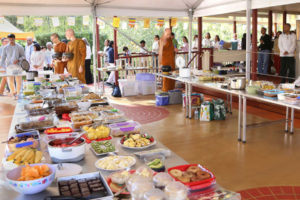
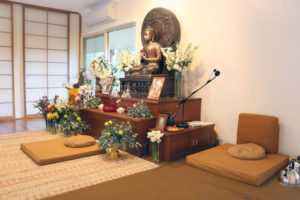
The Buddha Rupa
In 2008, Ty, a long-term supporter of the monastery, found herself stranded in a foreign country with an employer that refused to pay her, a debt of over twenty-thousand dollars, and a promise to Dhammagiri she feared she could not keep. The previous year, she’d offered to fund the casting of the main statue for the house-turned-Dhamma-Hall the monastery had just purchased at the base of their property. She’d felt confident that her new job in South Korea would allow her to cover the expenses. Upon arriving, however, she found herself working month after month for nothing as her employer delayed paying her salary. Nonetheless, she felt unwilling to back out on her offer of faith and would tell no one.
Ty had first come to Dhammagiri in 2006 and immediately felt moved by the sincerity of the monks’ practice: “I was impressed by the simplicity of the place—by how the monks were sitting on very simple cushions—not on high chairs like I used to see at the other monasteries, by the tent that they used as a Dhamma hall, and by the precepts that the monks practice. Ajahn Dhammasiha doesn’t accept money. It’s difficult to find those sort of things in this modern world.”
Ty visited often until, in 2009, she received a job offer in Korea. Stopping in Bangkok on her way to Seoul, she learned that her old teacher, a respected Vietnamese monk named Bhante Dhammarakata, was also there casting a Buddha statue for a stupa in Saigon. Visiting him, Ty asked about an aspiration that had come with her to Thailand: “The Buddha statue at Dhammagiri was chipped on the top of the Buddha’s head, so I had made the wish that I might offer a new statue. My teacher showed me the statue that he was planning to cast, and said that he’d modified it so that it would not belong to any particular culture – it would be universal.”
When Ty offered to fund the casting of a similar image, Ajahn Dhammasiha immediately agreed: “It represented exactly what we were. I’m a German ordained in Sri Lanka practicing in a Thai tradition with a monastery in Australia. We have some Chinese and Vietnamese supporters, and many Sri Lankans, so how about having a Buddha rupa that blends all the different features and uses as a basis the famous Dhammacakka Buddha statue in Sarnath?”.
Though Ty offered to lead the donation, she went along with Ajahn Dhammasiha’s suggestion that others in Dhammagiri’s community be allowed to contribute if they wished. This decision was especially fortuitous, as the new job she hoped to get funds from had its own issues. Bankrupt, the company she’d signed with continued to promise her paychecks that never came. In the end, she worked for a year without pay but, unwilling to rescind her promise, told no one at the monastery.
Ty commented on the whole situation later with a smile: “It brought up a bit of worry, to be honest, but I knew that one thing I could do is put down my house in Brisbane and use the money to pay. When I thought of that, I felt more confident. I could always sell the house and have enough cash to pay for the Buddha statue.”
When Ty returned home, still unpaid, from her year abroad, she found that Dhammagiri’s community had donated nearly the entire cost of the casting. She still wonders at the series of coincidence that surrounded the story: “Everything lined up—I wished I could offer something nicer than the current statue, I met my teacher in Bangkok, I got to know about the story of that Buddha statue, and Ajahn Dhammasiha liked that it was a universal image. Everything has its own karma.”
Several months later, Luang Por Liem, a senior monk in the Thai Forest Tradition and Ajahn Chah’s successor, inaugurated Dhammagiri with a visit. The day of his arrival, Dr. Gamini looked up from his gardening to find the monastery’s pond of lotuses, dormant since their planting three years earlier, all suddenly bloomed with white faces opened to the Australian sunlight.

